Leonotis nepetifolia does not really have a name in Lao; however, we have often seen it in abandoned dry fields. It doesn’t attract much attention here, yet elsewhere, it is a well-known medicinal and decorative plant. Originating from South Africa, it has been introduced to all warm regions of the globe.
It is an annual or perennial herb, reaching 0.5 to 2 meters in height. Its straight and rigid stem, with few branches, has four well-defined angles. The leaves are simple, opposite, corrugated, and hairy, triangular in shape with a toothed margin. The flowers are grouped in capitula forming pompoms or rounded heads, spaced along the stem and bordered at the base by smaller leaves. Each flower is a bright orange tube emerging from a bract that becomes stiff and brown when dried.
It appears that this flower has influenced the scientific and English name of the plant, “Lion’s ear” and in the same species, there is also “Lion’s tail”. In France, this plant is rare, but it is common in the Caribbean, where it is called “pompon soldat” in Creole, referring to the pompom that sailors have on their beret. In sub-Saharan Africa, its common name is klip dagga, with “dagga” being the slang or vernacular name for cannabis. In Mexico, the plant is called “marihuanilla“, meaning “little marijuana”. One of the most common uses of Leonotis is to be smoked or infused for a calming, euphoric, or even hallucinogenic effect.
If you go online, you will find numerous sites offering this plant in dried leaves, resin, or tincture. In Thailand, where it is called chat Pha In (referring to the god Indra), it competes with the famous banned kratom classified as a narcotic, while the use of Leonotis is free. However, there is limited scientific or anthropological evidence to evaluate this “drug”. It is noted that the leaves are aromatic, like many plants in this family (mint, basil), but they are also stinging and can cause dermatitis.
In many tropical regions, pompon soldat is simply considered an effective medicinal plant. In the Caribbean, it is believed to be good for intestinal worms and is diuretic. In the past, it was even made into an elixir sold in pharmacies, and today, the flowers are macerated in rum to obtain a restorative drink. In Africa, it is also reputed to be an antidote for snakebites and a talisman to keep them away.
In Laos, we found no one to tell us about this herb, but when you recognize it by its large pompoms in a wasteland, you will then remember its significance elsewhere.
Leonotis nepetifolia n’a pas vraiment de nom en lao, pourtant nous l’avons vue souvent dans les terrains secs laissés à l’abandon; elle n’intéresse pas grand monde ici alors qu’ailleurs elle est une plante médicinale et décorative notoire; venue du sud de l’Afrique elle a été introduite dans toutes les régions chaudes du globe.
C’est une herbe annuelle ou vivace de 0,5 à 2 m de haut; sa tige droite et rigide, peu ramifiée, possède quatre angles bien marqués. Ses feuilles sont simples, opposées, gaufrées, poilues; de forme triangulaire elles ont une marge dentée. Les fleurs sont groupées en capitules formant des pompons ou des têtes rondes hérissées, espacés tout au long de la tige, bordés à la base de feuilles plus petites; chaque fleur est un tube orange vif qui émerge d’une bractée devenant rigide et brune en séchant.
Il semble que ce soit cette fleur qui ait induit le nom scientifique et anglais de la plante, « oreille de lion », et dans la même espèce on a aussi « queue de lion ». En France cette plante est rare, mais elle est courante aux Antilles où on la nomme « pompon soldat » en créole, en référence au pompon que les marins ont sur leur béret. En Afrique subsaharienne son nom véhiculaire est klip dagga, « dagga » étant le nom argotique ou vernaculaire du cannabis; au Mexique la plante est nommée « marihuanilla », c’est-à-dire « petite marijuana ». Car l’un des usages les plus répandus de Leonotis est d’être fumée ou bue en infusion, pour obtenir un effet calmant ou euphorique, voire hallucinogène. Si vous allez sur internet vous trouverez de très nombreux sites qui vous proposent cette plante en feuilles sèches, en résine, en teinture; en Thaïlande, où on la nomme chat Pha In (référence au dieu Indra) elle fait concurrence au fameux kratom interdit et classé comme narcotique, alors que l’usage de Leonotis est libre. En fait, on a très peu d’éléments scientifiques ou anthropologiques pour évaluer cette « drogue ». On constate que les feuilles sont aromatiques, comme beaucoup de plantes de cette famille (menthe, basilic.) mais aussi qu’elles sont urticantes et qu’elles peuvent causer des dermatites.
Dans de nombreuses régions tropicales pompon soldat est simplement considérée comme une plante médicinale efficace. Ainsi aux Antilles elle est bonne pour les vers intestinaux et elle est diurétique; on en faisait même autrefois un élixir vendu en pharmacie et aujourd’hui on fait macérer les fleurs dans du rhum pour obtenir une boisson reconstituante. En Afrique elle est aussi réputée comme antidote des morsures de serpent et comme talisman pour les éloigner.
Au Laos nous n’avons trouvé personne pour nous parler de cette herbe, mais lorsque vous la reconnaîtrez à ses gros pompons dans une friche, vous vous souviendrez alors de son importance ailleurs.
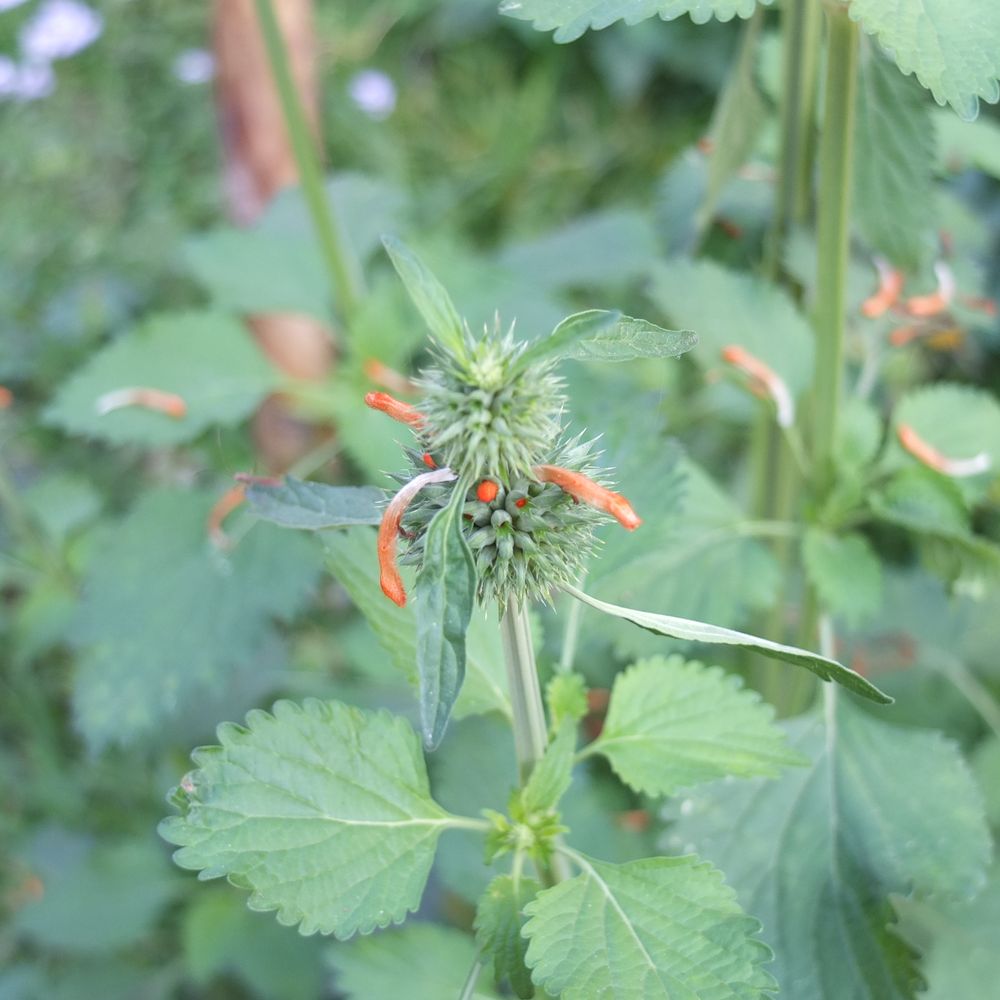
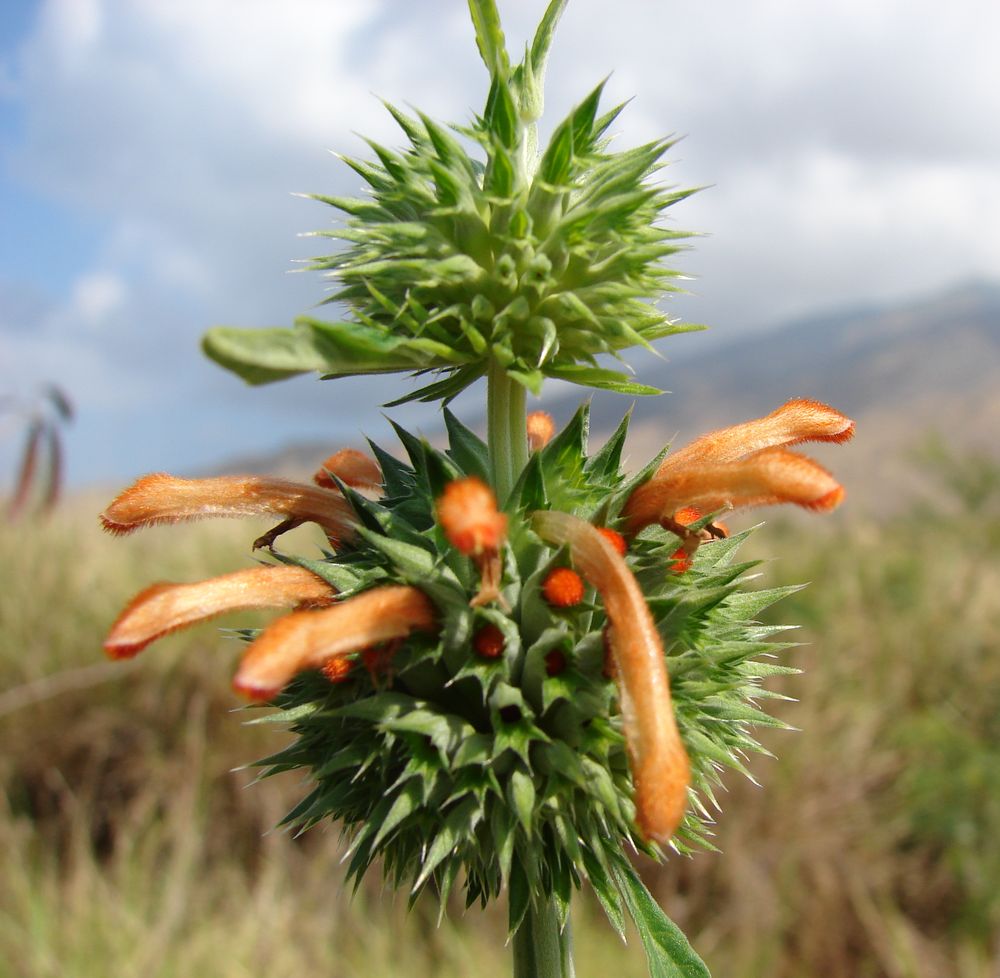
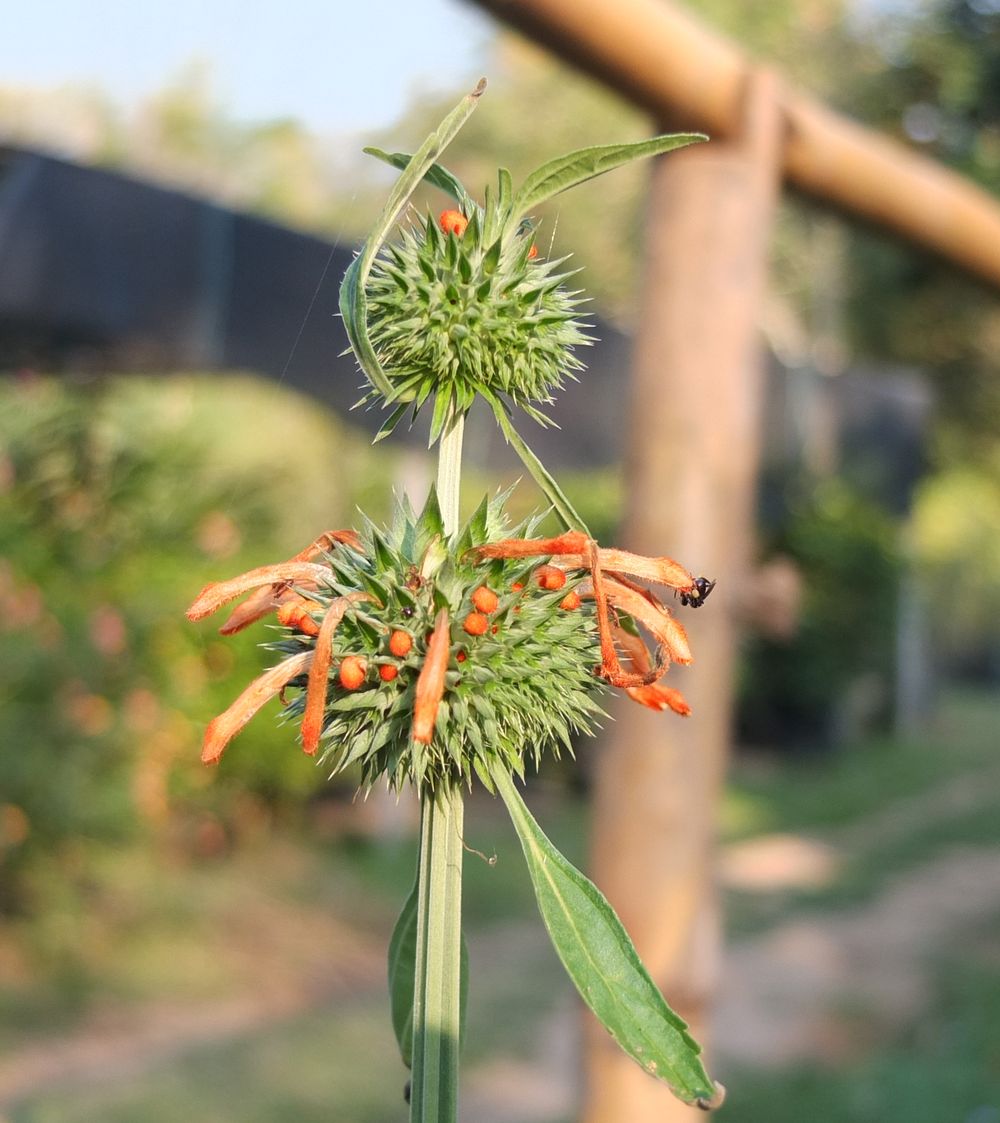
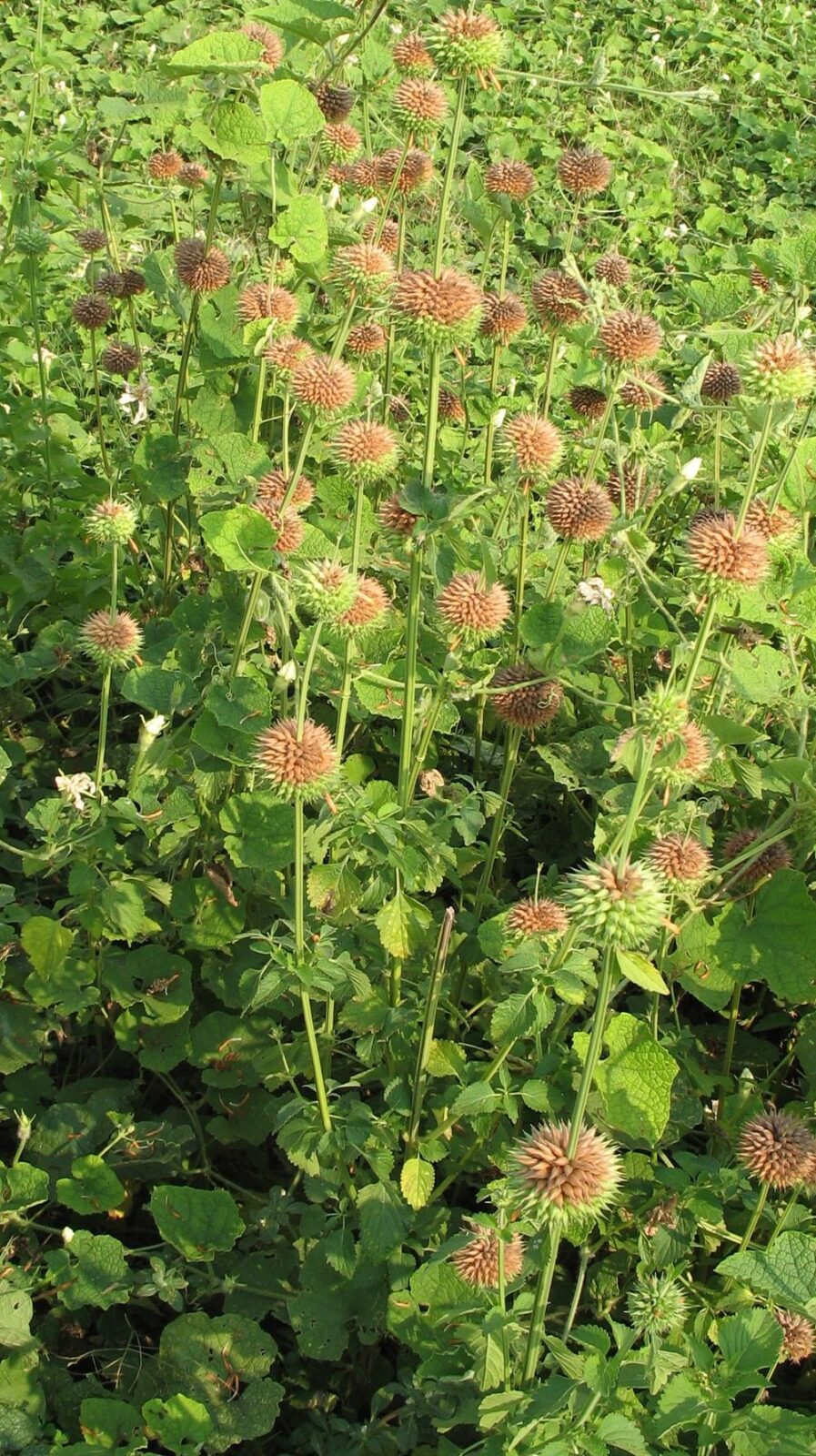
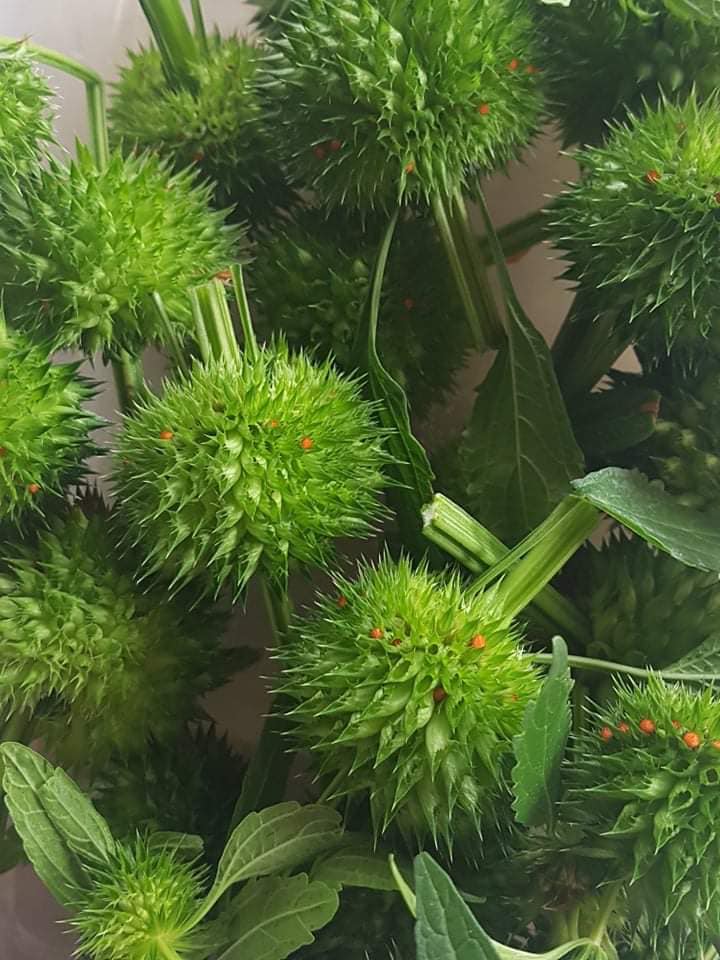
Leonotis nepetifolia does not really have a name in Lao; however, we have often seen it in abandoned dry fields. It doesn’t attract much attention here, yet elsewhere, it is a well-known medicinal and decorative plant. Originating from South Africa, it has been introduced to all warm regions of the globe.
It is an annual or perennial herb, reaching 0.5 to 2 meters in height. Its straight and rigid stem, with few branches, has four well-defined angles. The leaves are simple, opposite, corrugated, and hairy, triangular in shape with a toothed margin. The flowers are grouped in capitula forming pompoms or rounded heads, spaced along the stem and bordered at the base by smaller leaves. Each flower is a bright orange tube emerging from a bract that becomes stiff and brown when dried.
It appears that this flower has influenced the scientific and English name of the plant, “Lion’s ear” and in the same species, there is also “Lion’s tail”. In France, this plant is rare, but it is common in the Caribbean, where it is called “pompon soldat” in Creole, referring to the pompom that sailors have on their beret. In sub-Saharan Africa, its common name is klip dagga, with “dagga” being the slang or vernacular name for cannabis. In Mexico, the plant is called “marihuanilla“, meaning “little marijuana”. One of the most common uses of Leonotis is to be smoked or infused for a calming, euphoric, or even hallucinogenic effect.
If you go online, you will find numerous sites offering this plant in dried leaves, resin, or tincture. In Thailand, where it is called chat Pha In (referring to the god Indra), it competes with the famous banned kratom classified as a narcotic, while the use of Leonotis is free. However, there is limited scientific or anthropological evidence to evaluate this “drug”. It is noted that the leaves are aromatic, like many plants in this family (mint, basil), but they are also stinging and can cause dermatitis.
In many tropical regions, pompon soldat is simply considered an effective medicinal plant. In the Caribbean, it is believed to be good for intestinal worms and is diuretic. In the past, it was even made into an elixir sold in pharmacies, and today, the flowers are macerated in rum to obtain a restorative drink. In Africa, it is also reputed to be an antidote for snakebites and a talisman to keep them away.
In Laos, we found no one to tell us about this herb, but when you recognize it by its large pompoms in a wasteland, you will then remember its significance elsewhere.
Leonotis nepetifolia n’a pas vraiment de nom en lao, pourtant nous l’avons vue souvent dans les terrains secs laissés à l’abandon; elle n’intéresse pas grand monde ici alors qu’ailleurs elle est une plante médicinale et décorative notoire; venue du sud de l’Afrique elle a été introduite dans toutes les régions chaudes du globe.
C’est une herbe annuelle ou vivace de 0,5 à 2 m de haut; sa tige droite et rigide, peu ramifiée, possède quatre angles bien marqués. Ses feuilles sont simples, opposées, gaufrées, poilues; de forme triangulaire elles ont une marge dentée. Les fleurs sont groupées en capitules formant des pompons ou des têtes rondes hérissées, espacés tout au long de la tige, bordés à la base de feuilles plus petites; chaque fleur est un tube orange vif qui émerge d’une bractée devenant rigide et brune en séchant.
Il semble que ce soit cette fleur qui ait induit le nom scientifique et anglais de la plante, « oreille de lion », et dans la même espèce on a aussi « queue de lion ». En France cette plante est rare, mais elle est courante aux Antilles où on la nomme « pompon soldat » en créole, en référence au pompon que les marins ont sur leur béret. En Afrique subsaharienne son nom véhiculaire est klip dagga, « dagga » étant le nom argotique ou vernaculaire du cannabis; au Mexique la plante est nommée « marihuanilla », c’est-à-dire « petite marijuana ». Car l’un des usages les plus répandus de Leonotis est d’être fumée ou bue en infusion, pour obtenir un effet calmant ou euphorique, voire hallucinogène. Si vous allez sur internet vous trouverez de très nombreux sites qui vous proposent cette plante en feuilles sèches, en résine, en teinture; en Thaïlande, où on la nomme chat Pha In (référence au dieu Indra) elle fait concurrence au fameux kratom interdit et classé comme narcotique, alors que l’usage de Leonotis est libre. En fait, on a très peu d’éléments scientifiques ou anthropologiques pour évaluer cette « drogue ». On constate que les feuilles sont aromatiques, comme beaucoup de plantes de cette famille (menthe, basilic.) mais aussi qu’elles sont urticantes et qu’elles peuvent causer des dermatites.
Dans de nombreuses régions tropicales pompon soldat est simplement considérée comme une plante médicinale efficace. Ainsi aux Antilles elle est bonne pour les vers intestinaux et elle est diurétique; on en faisait même autrefois un élixir vendu en pharmacie et aujourd’hui on fait macérer les fleurs dans du rhum pour obtenir une boisson reconstituante. En Afrique elle est aussi réputée comme antidote des morsures de serpent et comme talisman pour les éloigner.
Au Laos nous n’avons trouvé personne pour nous parler de cette herbe, mais lorsque vous la reconnaîtrez à ses gros pompons dans une friche, vous vous souviendrez alors de son importance ailleurs.










Leonotis nepetifolia does not really have a name in Lao; however, we have often seen it in abandoned dry fields. It doesn’t attract much attention here, yet elsewhere, it is a well-known medicinal and decorative plant. Originating from South Africa, it has been introduced to all warm regions of the globe.
It is an annual or perennial herb, reaching 0.5 to 2 meters in height. Its straight and rigid stem, with few branches, has four well-defined angles. The leaves are simple, opposite, corrugated, and hairy, triangular in shape with a toothed margin. The flowers are grouped in capitula forming pompoms or rounded heads, spaced along the stem and bordered at the base by smaller leaves. Each flower is a bright orange tube emerging from a bract that becomes stiff and brown when dried.
It appears that this flower has influenced the scientific and English name of the plant, “Lion’s ear” and in the same species, there is also “Lion’s tail”. In France, this plant is rare, but it is common in the Caribbean, where it is called “pompon soldat” in Creole, referring to the pompom that sailors have on their beret. In sub-Saharan Africa, its common name is klip dagga, with “dagga” being the slang or vernacular name for cannabis. In Mexico, the plant is called “marihuanilla“, meaning “little marijuana”. One of the most common uses of Leonotis is to be smoked or infused for a calming, euphoric, or even hallucinogenic effect.
If you go online, you will find numerous sites offering this plant in dried leaves, resin, or tincture. In Thailand, where it is called chat Pha In (referring to the god Indra), it competes with the famous banned kratom classified as a narcotic, while the use of Leonotis is free. However, there is limited scientific or anthropological evidence to evaluate this “drug”. It is noted that the leaves are aromatic, like many plants in this family (mint, basil), but they are also stinging and can cause dermatitis.
In many tropical regions, pompon soldat is simply considered an effective medicinal plant. In the Caribbean, it is believed to be good for intestinal worms and is diuretic. In the past, it was even made into an elixir sold in pharmacies, and today, the flowers are macerated in rum to obtain a restorative drink. In Africa, it is also reputed to be an antidote for snakebites and a talisman to keep them away.
In Laos, we found no one to tell us about this herb, but when you recognize it by its large pompoms in a wasteland, you will then remember its significance elsewhere.
Leonotis nepetifolia n’a pas vraiment de nom en lao, pourtant nous l’avons vue souvent dans les terrains secs laissés à l’abandon; elle n’intéresse pas grand monde ici alors qu’ailleurs elle est une plante médicinale et décorative notoire; venue du sud de l’Afrique elle a été introduite dans toutes les régions chaudes du globe.
C’est une herbe annuelle ou vivace de 0,5 à 2 m de haut; sa tige droite et rigide, peu ramifiée, possède quatre angles bien marqués. Ses feuilles sont simples, opposées, gaufrées, poilues; de forme triangulaire elles ont une marge dentée. Les fleurs sont groupées en capitules formant des pompons ou des têtes rondes hérissées, espacés tout au long de la tige, bordés à la base de feuilles plus petites; chaque fleur est un tube orange vif qui émerge d’une bractée devenant rigide et brune en séchant.
Il semble que ce soit cette fleur qui ait induit le nom scientifique et anglais de la plante, « oreille de lion », et dans la même espèce on a aussi « queue de lion ». En France cette plante est rare, mais elle est courante aux Antilles où on la nomme « pompon soldat » en créole, en référence au pompon que les marins ont sur leur béret. En Afrique subsaharienne son nom véhiculaire est klip dagga, « dagga » étant le nom argotique ou vernaculaire du cannabis; au Mexique la plante est nommée « marihuanilla », c’est-à-dire « petite marijuana ». Car l’un des usages les plus répandus de Leonotis est d’être fumée ou bue en infusion, pour obtenir un effet calmant ou euphorique, voire hallucinogène. Si vous allez sur internet vous trouverez de très nombreux sites qui vous proposent cette plante en feuilles sèches, en résine, en teinture; en Thaïlande, où on la nomme chat Pha In (référence au dieu Indra) elle fait concurrence au fameux kratom interdit et classé comme narcotique, alors que l’usage de Leonotis est libre. En fait, on a très peu d’éléments scientifiques ou anthropologiques pour évaluer cette « drogue ». On constate que les feuilles sont aromatiques, comme beaucoup de plantes de cette famille (menthe, basilic.) mais aussi qu’elles sont urticantes et qu’elles peuvent causer des dermatites.
Dans de nombreuses régions tropicales pompon soldat est simplement considérée comme une plante médicinale efficace. Ainsi aux Antilles elle est bonne pour les vers intestinaux et elle est diurétique; on en faisait même autrefois un élixir vendu en pharmacie et aujourd’hui on fait macérer les fleurs dans du rhum pour obtenir une boisson reconstituante. En Afrique elle est aussi réputée comme antidote des morsures de serpent et comme talisman pour les éloigner.
Au Laos nous n’avons trouvé personne pour nous parler de cette herbe, mais lorsque vous la reconnaîtrez à ses gros pompons dans une friche, vous vous souviendrez alors de son importance ailleurs.


